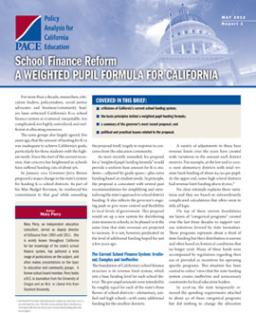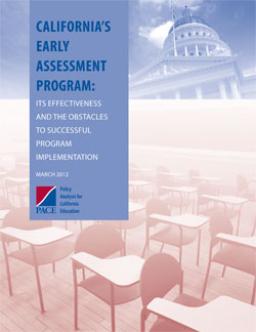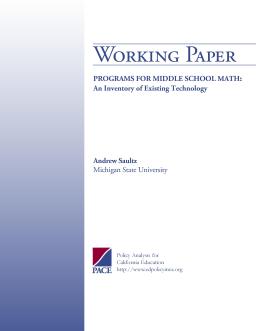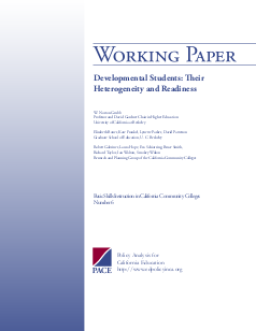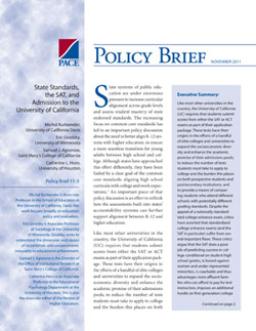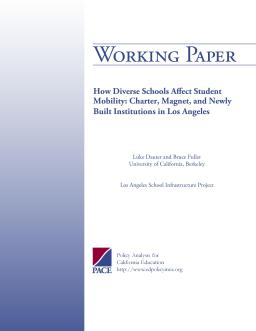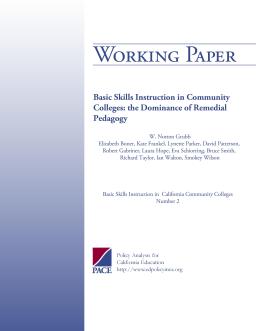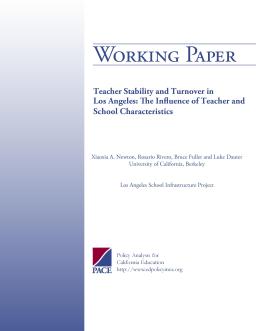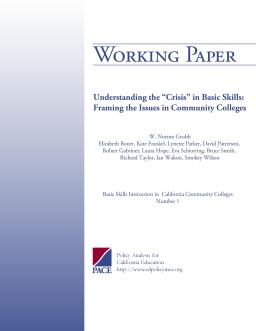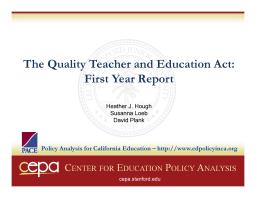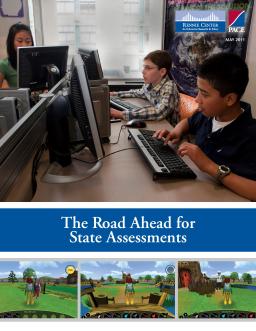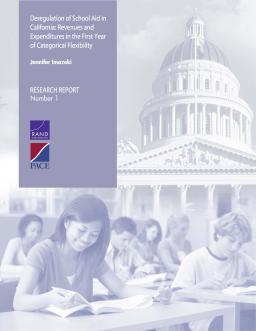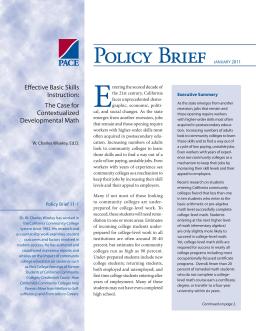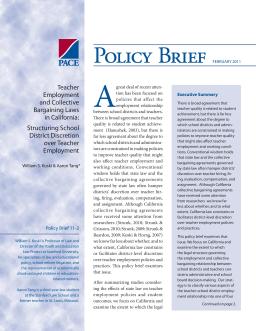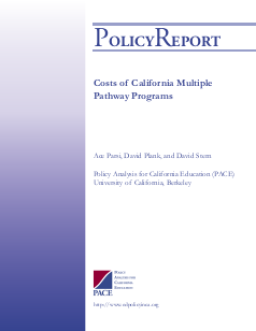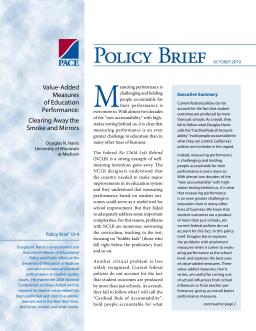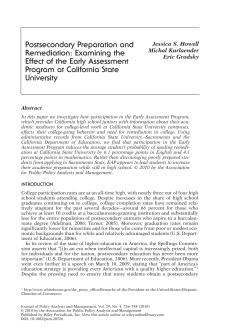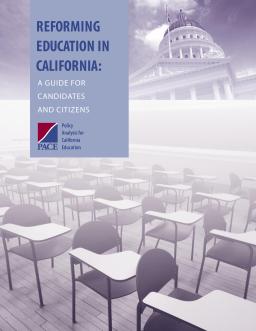A Weighted Pupil Formula for California
Published
Summary
Governor Jerry Brown has called for a major overhaul of California’s school finance policies. His proposal for a weighted pupil funding system would simplify the rules that govern the distribution of funds to schools and school districts, while targeting a larger share of available resources to the schools and students with the greatest needs. In this policy report Mary Perry offers an overview and analysis of the policy change that the Governor has proposed.
Its Effectiveness and the Obstacles to Successful Program Implementation
Published
Summary
The Early Assessment Program (EAP) is a national model for increasing the number of students who are prepared for college and careers upon graduating high school. It has been recognized by two national consortia as the model for designing new high school assessments aligned with Common Core State Standards. The report highlights the EAP's key features and potential to strengthen coherence and alignment in California's educational system, reviews research on its impact on student success, and suggests modifications to increase its value to students and educators.
An Inventory of Existing Technology
Published
Summary
The paper inventories technology programs available for middle school math—not as a guide. Some descriptions may not be accurate, and web addresses are included for reference. The report showcases the variety of programs available but notes few have been rigorously evaluated. Policymakers and educators have many options to incorporate technology into middle school math.
Chaffey College’s Long Journey to Success
Published
Summary
Chaffey College in California's Inland Empire is renowned for its "risk tolerant change-oriented culture" and impressive student support programs, which have led to exceptional outcomes for Chaffey students. In this working paper, researchers visited Chaffey and other California colleges to examine the quality of instruction in basic skills and the integration of student support services. Chaffey's success story highlights the importance of developing a broad structure necessary for success both in developmental education and for all students.
Their Heterogeneity and Readiness
Published
Summary
This paper examines basic skills education in California Community Colleges and the heterogeneity of students in developmental classrooms. Some students simply need to brush up on existing skills while others have learning disabilities or mental health issues. The paper argues that colleges need to be further differentiated to respond to the variety of student needs and offers suggestions for doing so.
From Governance to Capacity Building
Published
Summary
Education reform efforts in Los Angeles and the US have failed due to the focus on governance and rules. The solution is to invest in capacity building, creating incentives and agency for students and teachers, easing adoption through regulatory relief, and financing those working on new learning models. The goal is to update the century-old model of learning, called Learning 1.0, with a new model, Learning 2.0, that builds an education system around the learning system. This approach is based on research into unconventional learning models.
Their Possibilities and Limits
Published
Summary
The voluntary nature of student support services in California Community Colleges means that many students who need them do not use them, due to competing demands or stigma. The lack of funding for student services and the prevalence of adjunct faculty further complicates their use. Challenging conventional practices and norms of community colleges could make the entire enterprise of developmental education more effective.
Published
Summary
The University of California (UC) requires the SAT or ACT as part of their admissions process, but critics argue that these tests have flaws and are biased. This brief suggests that state-mandated standardized tests used to monitor student progress in secondary education, such as the CST exam in California, could be a suitable substitute for college entrance exams. The analysis in this brief shows that the CST exam offers similar predictive power for college performance and persistence at UC, compared to the SAT.
The Landscape and the Locus of Change
Published
Summary
This PACE working paper examines six types of innovations to improve developmental education in California Community Colleges: individual practitioner efforts, departmental developments, learning communities, K-12 initiatives, Faculty Interest Groups, and innovation from the middle. The authors find that there are many good ideas for improving developmental education, but success depends on nurturing the right conditions for innovation. Innovation from the middle, with the joint efforts of senior-level faculty and middle-level administrators, seems necessary for widespread reform.
Charter, Magnet, and Newly Built Campuses in Los Angeles
Published
Summary
This paper examines the impact of pupil mobility in urban districts like Los Angeles, where families are encouraged to switch schools due to the growth of mixed-markets of charter, magnet, and pilot schools. African American and White students are more likely to exit their schools, while overcrowding in low-income Latino neighborhoods leads to higher exit rates. Charter and magnet school students exit less. The district's commitment to relieve overcrowding leads to Latino students moving to newly built schools. The opening of new high schools reduced pupil mobility.
The Dominance of Remedial Pedagogy
Published
Summary
This working paper examines the instructional triangle of basic skills education in California Community Colleges through classroom observations in 13 colleges. The study identifies the prevalence of remedial pedagogy, which relies on sub-skill drill and practice and lacks connections to subsequent courses or adult roles. This approach is ineffective and violates precepts of effective instruction. The paper outlines alternatives to remedial pedagogy, including hybrid and constructivist teaching. These alternatives are further developed in Working Paper 3.
The Influence of Teacher and School Characteristics
Published
Summary
This study explores how teacher characteristics and school context affect the timing of teacher exits from schools, using a two-level discrete-time survival analysis framework. Results for Los Angeles Unified School District show that school context is crucial, especially type of school and organizational characteristics, beyond individual teacher qualifications. Differences between elementary and secondary teachers are also observed.
Framing the Issues in Community Colleges
Published
Summary
This paper series addresses the issue of basic skills instruction in California Community Colleges. The problem is twofold: a high proportion of students enter college needing developmental courses, and these students are unlikely to move into college-level work. The research focuses on instructional issues, with observations and interviews to understand classroom and institutional settings. The subsequent papers in the series will cover various hypotheses for why success rates in basic skill instruction are not higher.
First Year Report
Published
Summary
The Quality Teacher and Education Act (QTEA) was passed in 2008 in San Francisco, authorizing $198 per taxable property to be collected by the SFUSD for 20 years. CEPA and PACE collaborated with the SFUSD to evaluate the implementation and impact of QTEA on teacher compensation, support, and accountability. This report documents the first-year implementation of QTEA and its effects on the recruitment and retention of high-quality teachers, improvement of the teacher workforce, and removal of less effective teachers using a mixed-methods approach.
Published
Summary
This report provides policy guidance for new state assessments aligned to Common Core State Standards. It aims to inform the work of the two consortia funded by the U.S. Department of Education in developing the assessments. The report includes three papers addressing issues of computer adaptive assessments, assessment of English learners, and assessing science. The authors' vision of new assessments goes beyond the horizon of current practice and emphasizes the need to use new technologies to provide useful and timely information to students and teachers.
How 10 Districts Responded to Fiscal Flexibility, 2009–2010
Published
Summary
This report explores how 10 California school districts responded to the deregulation of $4.5 billion in education funding, which became entirely flexible in 2009. The study investigates how district leaders made budget decisions and what local factors influenced their responses. The research was conducted by a team of scholars from the RAND Corporation, UC Berkeley, UC Davis, and San Diego State University.
Revenues and Expenditure in the First Year of Categorical Flexibility
Published
Summary
This report discusses the effects of California's partial release of categorical funds to local school boards in 2009. The increased flexibility has provided an opportunity to observe how districts respond to the policy change, but the impact is difficult to isolate as most districts have been struggling to maintain core services during a severe budget crisis. The report includes preliminary results from an ongoing study of district responses to the increased categorical flexibility.
The Case for Contextualized Developmental Math
Published
Summary
This brief analyzes the effectiveness of contextualized developmental math in California Community Colleges, where fewer than 10% of students who enter at the basic math level complete college-level math. These integrated courses focus on math required in specific occupations and have higher success rates than traditional math courses. However, the pressure for traditional academic courses has eliminated many of these courses, hindering students' ability to acquire occupational skills and complete advanced courses or degrees.
Structuring School District Discretion over Teacher Employment
Published
Summary
This brief analyzes the relationship between teacher employment, collective bargaining laws, and school district policies in California. The authors examine the extent to which California's legal structure constrains or facilitates district-level discretion over teacher employment policies and practices. They classify various aspects of the teacher-school district employment relationship into four categories, and conclude that California statutory law is somewhat more constraining of administrative decision-making in teacher employment matters than in four other large and diverse states.
Published
Summary
The James Irvine Foundation sponsors the Linked Learning approach as a strategy for improving California high schools' performance. PACE was asked to gather evidence on the cost of linked learning programs. The report explores how traditional high schools use their resources and how much school districts spend on their high schools to achieve current performance. It proves challenging to judge whether reform strategies like Linked Learning cost more than, less than, or the same as traditional high school programs.
Clearing Away the Smoke and Mirrors
Published
Summary
This brief examines the strengths and weaknesses of value-added measures, which are useful for separating out school influences from other factors when evaluating teacher and school performance. Although value-added assessments give a summative picture of teacher performance, they do not provide guidance on how to improve. The author explores best uses and practices for value-added measures and discusses the limitations of attainment measures in evaluating school performance. The "Cardinal Rule of Accountability" is to hold people accountable for what they can control.
Examining the Effect of the Early Assessment Program at California State University
Published
Summary
This study analyzes the impact of the Early Assessment Program (EAP) on the college-going behavior and remediation needs of California high school juniors. Results show that EAP participation reduces the need for remediation at California State Universities by 6.1 percentage points in English and 4.1 percentage points in mathematics. The program does not discourage poorly prepared students from applying to college but rather encourages them to increase their academic preparation in high school.
California’s Quality Education Investment Act
Published
Summary
This working paper examines the use of Quality Education Investment Act (QEIA) funds, which allocated $2.6B over seven years to California's lowest-performing schools. The authors conducted a study of four Los Angeles high schools to investigate how QEIA dollars were spent in the first year, who made the decisions, and how funds were used to improve teaching and the instructional program. The study found that district officials and principals had discretion in allocating funds, consistent with recent efforts to deregulate categorical-aid programs and give local educators fiscal discretion.
Assessing the Impact of the California Governor’s Teaching Fellowship
Published
Summary
This brief evaluates the effectiveness of CA's Governor's Teaching Fellowship, which aimed to recruit and retain highly qualified teachers in low-performing schools by providing a $20K fellowship to individuals enrolled in traditional teacher licensure programs who agreed to teach in designated schools. The study found that financial incentives can attract skilled professionals to work with underserved populations, but alternative policy designs should also be explored for cost-effectiveness. The results of the evaluation have important implications for state and national education policy.
A Guide for Citizens and Candidates
Published
Summary
PACE has published a policy book to support informed debates about the issues facing California education. The book includes recommendations to improve education quality, targeting resources to those who need it most, giving local schools more flexibility, and designing policies for continuous improvement. While there's no one solution to fix public education, a series of good policies can bring about fundamental reform and improve outcomes for schools and students.
